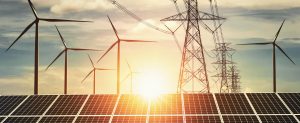President Joe Biden unveiled his “American Jobs Plan” last week, proposing a $2 trillion infrastructure investment. The American Jobs Plan aims to invest in the U.S. economy by tackling the country’s most pressing challenges – from crumbling roads, bridges, and water systems to a vulnerable electric grid, and at long-last taking needed measures to address the climate crisis.
This is the most comprehensive action proposal for addressing climate change we have ever seen from the White House, representing tremendous opportunities for a more resilient, safe, and prosperous future for all Americans.
“The American Job’s Plan presents a monumental opportunity for our nation to capitalize on clean energy technologies. We can tackle climate change while simultaneously rebuilding our economy, creating jobs and ensuring a resilient future here in Utah and across the country.” – Josh Craft, Government and Corporate Relations Manager for Utah Clean Energy.
Clean Energy and Climate Priorities
The American Jobs Plan’s goals include fixing highways and bridges, modernizing our electricity system, upgrading our water systems, building and retrofitting housing, and expand public transportation and freight rail service, as well as exciting investments in energy innovation and climate solutions. Importantly, the President’s plan makes equity and environmental justice a major focus, aiming for at least 40% of the benefits to go to disadvantaged communities. A few highlights include:
Modernizing the Power Sector Through Clean Energy Investment
Utah has a large and growing clean energy economy and abundant clean energy resources to draw upon. The plan has a focus on accelerating the adoption of clean energy resources by:
- A ten-year extension and phase-down of an expanded direct-pay investment tax credit and production tax credit for clean energy generation and storage.
- Establishing an Energy Efficiency and Clean Electricity Standard (EECES), requiring utilities to improve energy efficiency and increase the use of zero-emissions electricity resources.
- Expand electric transmission through a targeted investment tax credit and by creating a new Grid Deployment Authority at the U.S. Department of Energy.
- Utilize federal purchasing power to drive clean energy deployment across the market by purchasing 24/7 clean power for federal buildings.
Energy Efficient and Affordable Housing and Schools
- The plan focuses on building new and rehabilitating existing housing units, with $213 billion proposed in total for housing.
- A big portion of this funding will go towards energy efficiency and electrification of rental housing options and retrofitting existing homes through the Weatherization Assistance Program and tax credits for home and small commercial energy efficiency projects.
- Upgrading public school buildings also gets a big nod in the plan, including energy efficiency and resiliency measures.
Substantially Expanding Electric Vehicle (EV) Market
Utah has been making important strides to expand electric vehicle charging infrastructure and the American Jobs Plan proposes new investments to super-charge EV adoption.
- The plan includes a major investment of $174 billion in electric vehicles (EV) and electric vehicle infrastructure, including point of sale rebates for customers and tax incentives to buy American-made EVs.
- Would also create grant and incentive programs for state and local governments and the private sector to build a national network of 500,000 EV chargers by 2030.
- Aims to replace 50,000 diesel transit vehicles and electrify at least 20 percent of the yellow school bus fleet through a new “Clean Buses for Kids Program.”
Climate and Clean Energy Technology Innovation
Federal research, development, and deployment have been a major part of the cost reductions in LED lighting, solar PV technology, and lithium-ion batteries, which Utah companies have taken advantage of. The American Jobs Plan includes major new investments in energy innovation and deployment to do this for the next generation of technologies.
- The Plan proposes a $35 billion investment in energy innovation and climate solutions technologies to help address the climate crisis and position the U.S. as the global leader in clean energy technologies. Specifically:
- Launching ARPA-C to develop new methods for reducing emissions and building climate resilience, as well as expanding across-the-board funding for climate research.
- Investing $15 billion in demonstration projects for climate research and development priorities, including utility-scale energy storage, carbon capture, and storage, hydrogen, advanced nuclear, rare earth element separations, floating offshore wind, biofuel/bioproducts, quantum computing, and electric vehicles, as well as strengthening U.S. technological leadership in these areas in global markets.
- Establish a “National Clean Energy and Sustainability Accelerator,” a non-profit independent financial entity that will seek to drive adoption of proven and emerging clean energy technologies and climate solutions, with a focus on rural communities and communities of color.
- Proposes $27 billion in initial public capital to be distributed to state and local “clean energy funds or “green banks.”
- Technologies and building practices range from energy efficiency and electric heat pumps in buildings, distributed energy storage systems, and sustainable agriculture and forestation practices.
Energy Transition
We’d like to see a bit more in any major piece of energy legislation providing for investment in communities in Utah and elsewhere that are going to be experiencing significant energy transition in the coming years, especially those that host coal-fired power plants. That support is going to be critical to ensure that our rural communities can thrive in the next century. But we’re pleased to see that President Biden’s plan includes $16 billion in investments for oil and gas workers to plug orphaned oil and gas wells and reclaiming abandoned mines.
We are pleased to see this ambitious plan and we will be watching closely to see when the U.S. House and the U.S. Senate will move forward on legislation to implement the American Jobs Plan.
Paying for The Plan
The biggest fight in Congress is likely to be over how to pay for the $2 trillion in investments that President Biden is proposing. We note that infrastructure investments generally are worthwhile ones, generating new jobs and business opportunities that pay back over time. Not to mention the cost of inaction on climate change.
The President’s plan suggests raising the corporate tax rate, an idea that many business interests have opposed. We hope that there’s a discussion of how carbon pricing may factor in the plan, both to pay for some of the investments and to provide a market-based solution to reducing emissions. Senator Mitt Romney has expressed support for the Baker-Shultz Carbon Dividend Plan, a revenue-neutral carbon pricing proposal, though not one that would pay for new investments.
We are pleased to see this ambitious plan and we will be watching closely to see when the U.S. House and the U.S. Senate will move forward on legislation to implement the American Jobs Plan.







